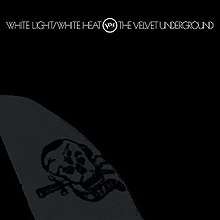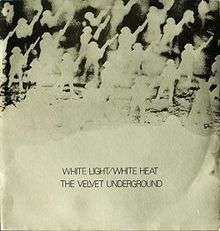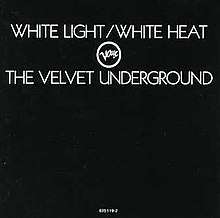White Light/White Heat
White Light/White Heat is the second studio album by American rock band the Velvet Underground, released in 1968 by record label Verve. It was the band's last studio recording of new material with bassist and founding member John Cale.
| White Light/White Heat | ||||
|---|---|---|---|---|
 | ||||
| Studio album by | ||||
| Released | January 30, 1968 | |||
| Recorded | September 1967 | |||
| Studio | Scepter, Manhattan | |||
| Genre | ||||
| Length | 40:13 | |||
| Label | Verve | |||
| Producer | Tom Wilson | |||
| The Velvet Underground chronology | ||||
| ||||
| 1976 UK reissue cover | ||||
 | ||||
| 1988 reissue cover | ||||
 | ||||
| Singles from White Light/White Heat | ||||
| ||||
Background
After the disappointing sales of the Velvet Underground's first album, The Velvet Underground & Nico (1967), the band's relationship with Andy Warhol deteriorated. They toured throughout most of 1967. Many of their live performances featured noisy improvisations that would become key elements on White Light/White Heat.[2] The band fired Warhol, parted ways with Nico,[3] and recorded their second album with Tom Wilson credited as producer.
Recording
The album was recorded in just two days, and with a noticeably different style from that of The Velvet Underground & Nico. Decades after its release, John Cale described White Light/White Heat as "a very rabid record... The first one had some gentility, some beauty. The second one was consciously anti-beauty."[4] Sterling Morrison said: "We were all pulling in the same direction. We may have been dragging each other off a cliff, but we were all definitely going in the same direction."[5]
Content
The album has been described as experimental rock,[6] noise rock,[7][8] proto-punk[9] and art rock[10] by writers and critics.
The record's lyrics vary from themes of drug use and sexual references (such as fellatio and orgies), including the song "Lady Godiva's Operation", about a transsexual woman's botched lobotomy,[11] and the title track "White Light/White Heat", which describes intravenous use of methamphetamine.[12]
"Here She Comes Now" is built around a double-entendre. On the album's last track, "Sister Ray", Lou Reed tells a tale of debauchery involving drag queens having a failed orgy, while the band plays an improvised seventeen-minute jam around three chords.
Album covers
The original album cover to White Light/White Heat is a faint image of a tattoo of a skull. The tattoo was that of Joe Spencer, who played the lead role in Warhol's 1967 film Bike Boy. Spencer starred as a hustler in a motorcycle gang and is seen taking a shower in the movie. Although he was not credited for the cover design as with their debut album, it was Warhol's idea to use a black-on-black picture of the tattoo. Reed selected the image from the negatives from the film, and it was enlarged and distorted by Billy Name, one of the members of the Factory.[13] It is difficult to distinguish the tattoo, as the image is black, printed on a slightly lighter black background. On this cover, the album name, the Verve logo, and the band name are all on one line.
An alternative cover was used for Polydor's mid-1980s reissues. This cover had a completely black background, without the arm in the background. On this version, the album name, Verve logo, and band name are printed on three separate lines.
There also exists a unique MGM Records UK cover, produced from 1976 until the early '80s, featuring a white background and abstract toy soldiers.
In 1974, the album was reissued by MGM under the title "Archetypes". The cover of this version features two men wearing helmets standing in front of a Woolworth's.[14]
Reception
| Review scores | |
|---|---|
| Source | Rating |
| AllMusic | |
| Chicago Tribune | |
| Encyclopedia of Popular Music | |
| The Guardian | |
| Pitchfork | 10/10[19] |
| Record Collector | |
| Rolling Stone | |
| The Rolling Stone Album Guide | |
| Spin Alternative Record Guide | 9/10[23] |
| Uncut | 10/10[24] |
Like other releases by the group, the album's socially transgressive lyrical themes and avant-garde instrumentation challenged popular music sensibilities at the time, creating a muted reception.[15] The album briefly appeared on the Billboard 200, peaking at number 199.[25] Retrospective reviews have been much more positive, with the album being listed at number 293 on Rolling Stone magazine's list of the 500 greatest albums of all time.[26] It was voted number 309 in the third edition of Colin Larkin's All Time Top 1000 Albums (2000).[27]
From 1991 to 2013, White Light/White Heat sold 113,000 copies in the U.S.[28]
Legacy
White Light/White Heat contains distorted, feedback-driven, and roughly recorded sound, which is regarded as influential.[29] British rock band Buzzcocks were formed by Pete Shelley and Howard Devoto out of a shared interest in "Sister Ray".[30]
Track listing
All tracks are written by Lou Reed except where noted.
| No. | Title | Writer(s) | Length |
|---|---|---|---|
| 1. | "White Light/White Heat" | 2:47 | |
| 2. | "The Gift" | Reed, Sterling Morrison, John Cale, Maureen Tucker | 8:18 |
| 3. | "Lady Godiva's Operation" | 4:56 | |
| 4. | "Here She Comes Now" | Reed, Morrison, Cale | 2:04 |
| Total length: | 18:05 | ||
| No. | Title | Writer(s) | Length |
|---|---|---|---|
| 1. | "I Heard Her Call My Name" | 4:38 | |
| 2. | "Sister Ray" | Reed, Morrison, Cale, Tucker | 17:28 |
| Total length: | 22:06 | ||
| No. | Title | Length |
|---|---|---|
| 7. | "I Heard Her Call My Name" (Alternate take) | 4:39 |
| 8. | "Guess I'm Falling In Love" (new mix) | 3:34 |
| 9. | "Temptation Inside Your Heart" (Original mix) | 2:33 |
| 10. | "Stephanie Says" (Original mix) | 2:50 |
| 11. | "Hey Mr. Rain" (Version one – new mix) | 4:40 |
| 12. | "Hey Mr. Rain" (Version two – new mix) | 5:24 |
| 13. | "Beginning to See the Light" (new mix – previously unreleased early version) | 3:39 |
| Total length: | 27:19 | |
| No. | Title | Length |
|---|---|---|
| 1. | "White Light/White Heat" | 2:47 |
| 2. | "The Gift" | 8:17 |
| 3. | "Lady Godiva's Operation" | 4:55 |
| 4. | "Here She Comes Now" | 2:04 |
| 5. | "I Heard Her Call My Name" | 4:38 |
| 6. | "Sister Ray" | 17:32 |
| 7. | "White Light/White Heat" (Mono single mix) | 2:48 |
| 8. | "Here She Comes Now" (Mono single mix) | 2:04 |
| 9. | "The Gift" (Vocal version) | 8:08 |
| 10. | "The Gift" (Instrumental version) | 8:16 |
| Total length: | 61:29 | |
| No. | Title | Length |
|---|---|---|
| 1. | "Booker T." | 6:46 |
| 2. | "I'm Not a Young Man Anymore" (previously unreleased) | 6:17 |
| 3. | "Guess I'm Falling in Love" | 4:10 |
| 4. | "I'm Waiting for the Man" (previously unreleased) | 5:28 |
| 5. | "Run Run Run" (previously unreleased) | 6:58 |
| 6. | "Sister Ray" (previously unreleased) | 19:03 |
| 7. | "The Gift" (previously unreleased) | 10:25 |
| Total length: | 59:07 | |
Personnel
- The Velvet Underground
- Lou Reed – lead vocals (1, 3, 4, 5, 6), lead guitar (2, 3, 5, 6), rhythm guitar (1, 4), cantaloupe (2)[31]
- John Cale – lead vocals (3), backing vocals (1, 5), spoken word (2), electric viola (3, 4), Vox Continental organ (6), piano (1, 4), bass guitar (1, 2, 4, 5), medical sound effects (3)
- Sterling Morrison – lead guitar (1, 2, 4, 6), rhythm guitar (5), bass guitar (3), backing vocals (1, 3, 4, 5), medical sound effects (3)
- Maureen Tucker – percussion (1–5), drums (6), tambourine (4)
- Technical personnel
- Gary Kellgren – recording engineer
- Bob Ludwig – mastering
- Val Valentin – director of engineering
- Tom Wilson – production
References
- https://www.discogs.com/The-Velvet-Underground-White-LightWhite-Heat-Here-She-Comes-Now/release/6293249
- Unterberger, Richie. "The Velvet Underground | Biography | AllMusic". AllMusic. Retrieved March 29, 2015.
- "1967". Warholstars.org. Retrieved March 29, 2015.
- Epstein, Dan (2018-01-30). "Velvet Underground's 'White Light/White Heat': 10 Things You Didn't Know". Rolling Stone. Retrieved 2018-07-23.
- David Fricke (2013). "Overloaded The Story of White Light/White Heat". Mojo.
- Pareles, Jon; Chinen, Nate (December 16, 2013). "After 45 Years, as Incendiary as Ever". The New York Times. The New York Times Company. Retrieved August 20, 2015.
- Deusner, Stephen M. (December 11, 2013). "Revisiting The Velvet Underground's White Light/White Heat". Paste. Paste Media Group. Retrieved August 21, 2015.
- Galen, Marjorie; Matthews, Gordon (September 1, 2007). Legends of Rock. Dalmatian Press. ISBN 978-1403737199.
- Edmondson, Jacqueline, ed. (October 3, 2013). Music in American Life: An Encyclopedia of the Songs, Styles, Stars, and Stories That Shaped Our Culture. Greenwood Publishing Group. p. 915. ISBN 978-0313393471. Retrieved August 20, 2015.
- Meic Stephens (23 September 1998). The new companion to the literature of Wales. University of Wales Press. p. 81. ISBN 978-0-7083-1383-1.
- "La Milanesiana 2007: Letteratura Musica Cinema". July 10, 2007. Retrieved April 29, 2012.
Come autore, ha scritto su temi quali il sadomasochismo (Venus in Furs), travestiti (Sister Ray), e transessuali sottoposti a lobotomia (Lady Godiva’s Operation). [As an author, he has written on topics such as sadomasochism (Venus in Furs), transvestites (Sister Ray), and transsexuals undergoing lobotomies (Lady Godiva's Operation).]
- Bockris, Victor; Malanga, Gerard (1983). Up-tight: The Velvet Underground Story. London: Omnibus Press. p. 93. ISBN 0-7119-0168-6.
- Unterberger, Richie (2009). White Light/White Heat: The Velvet Underground Day by Day. Outline Press Ltx. p. 178. ISBN 978-1-906002-81-7. Retrieved March 29, 2015.
- http://www.discogs.com/The-Velvet-Underground-Archetypes/release/981371
- Deming, Mark. "White Light/White Heat – The Velvet Underground". AllMusic. Retrieved March 29, 2015.
- Kot, Greg (January 12, 1992). "Lou Reed's Recordings: 25 Years Of Path-breaking Music". Chicago Tribune. Retrieved July 29, 2013.
- Larkin, Colin (2011). "The Velvet Underground". The Encyclopedia of Popular Music (5th concise ed.). Omnibus Press. ISBN 0-85712-595-8.
- Jonze, Tim (December 5, 2013). "The Velvet Underground: White Light/White Heat 45th Anniversary Super Deluxe Edition – review". The Guardian. London. Retrieved September 1, 2018.
- Wolk, Douglas (January 16, 2014). "The Velvet Underground: White Light/White Heat". Pitchfork. Retrieved January 16, 2014.
- Rathbone, Oregano (Christmas 2013). "The Velvet Underground – White Light/White Heat". Record Collector (422). Retrieved September 1, 2018.
- Fricke, David (March 14, 1985). "The Velvet Underground: The Velvet Underground & Nico / White Light/White Heat / The Velvet Underground / V.U.". Rolling Stone (443). Archived from the original on July 16, 2006. Retrieved September 3, 2006.
- Sheffield, Rob (2004). "The Velvet Underground". In Brackett, Nathan; Hoard, Christian (eds.). The New Rolling Stone Album Guide (4th ed.). London: Fireside Books. pp. 847–848. ISBN 0-7432-0169-8. Retrieved November 22, 2011. Portions posted at "The Velvet Underground > Album Guide". Rolling Stone. Archived from the original on September 27, 2011. Retrieved November 22, 2011.
- Weisbard, Eric; Marks, Craig, eds. (1995). "The Velvet Underground". Spin Alternative Record Guide. Vintage Books. ISBN 0-679-75574-8.
- Gill, Andy (January 23, 2014). "The Velvet Underground – White Light/White Heat Super Deluxe Edition". Uncut. Retrieved September 1, 2018.
- "The Velvet Underground, 'White Light/White Heat' – 500 Greatest Albums of All Time | Rolling Stone". Rolling Stone. Retrieved March 29, 2015.
- "500 Greatest Albums of All Time Rolling Stone's definitive list of the 500 greatest albums of all time". Rolling Stone. 2012. Retrieved September 9, 2019.
- Colin Larkin, ed. (2006). All Time Top 1000 Albums (3rd ed.). Virgin Books. p. 128. ISBN 0-7535-0493-6.
- http://www.billboard.com/biz/articles/news/legal-and-management/5770584/lou-reed-rip-what-if-everyone-who-bought-the-first
- Thompson, Jason. "The Velvet Underground: White Light/White Heat | PopMatters". PopMatters. Retrieved March 29, 2015.
- Andrew Hulttrans (April 2010). "Reissues". Spin: 92.
- https://www.rollingstone.com/music/music-features/the-velvet-undergrounds-white-light-white-heat-10-things-you-didnt-know-205478/
Further reading
- Fricke, David (November 2013). "Overloaded: The Story of White Light/White Heat". Mojo.